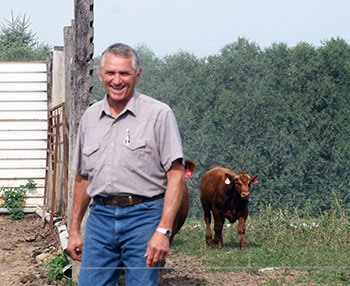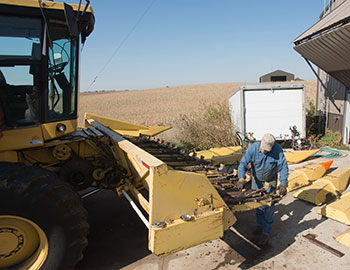DID YOU KNOW…
 In the US, the average age of the principal farm operator has steadily increased from 50 in 1978 to 57 in 2007. *
In the US, the average age of the principal farm operator has steadily increased from 50 in 1978 to 57 in 2007. * - The majority of US farm operators are between 45 and 64, but the fastest growing age group of farm operators is those 65 years and older. *
- In 2007, 30% of principal operators (over 665,000 farmers) were age 65 or older.
- Older farmers have over 2.5 times as many work-related fatalities as younger farmers. **
- Although older farmers have a lower rate of non-fatal injuries than younger farmers, the injuries they do experience are usually more severe in nature. **
- 1 in 9 farmers over age 55 have been involved in a tractor rollover, the most common cause of occupational death among farmers.
- The next most common causes of severe or fatal work-related injuries for older farmers are livestock (cattle) and falls from moving tractors, farm equipment, or structures.
* 2007 US Census of Agriculture
** For these statistics, “older farmers” refers to those age 55 and above
Who is at risk?
Farmers are a robust group, unique among the general population for working well beyond normal retirement age, often into their 70s and 80s. At advanced ages, some farmers scale back their operations or work hours, or turn over some of the most physically demanding tasks to family members or employees while still remaining active in crop or livestock production.
Common conditions associated with the normal aging process can increase older farmers’ risk of injury. These age-related conditions include:
 Declining vision, which affects the ability to protect oneself from hazards. Older eyes require more illumination to perceive images than young eyes, have a harder time distinguishing items where there is inadequate light/dark contrast, and are more sensitive to glare from bright sunlight or vehicle headlights at night. Peripheral vision also declines with age.
Declining vision, which affects the ability to protect oneself from hazards. Older eyes require more illumination to perceive images than young eyes, have a harder time distinguishing items where there is inadequate light/dark contrast, and are more sensitive to glare from bright sunlight or vehicle headlights at night. Peripheral vision also declines with age.- Hearing loss, which can affect one’s ability to detect hazards nearby. Hearing loss is more severe among farmers.
- Declines in strength, mobility, balance, range of motion, and reflexes, which increase the potential for falls and injuries related to machinery and animals.
- Arthritis, which affects one third of farmers and ranch operators and impairs strength and mobility.
Working alone increases the risk of a farm-related injury for older farmers, as do previous injuries that limit the ability to do farm work. And, farmers are no different from other experienced workers who perform the same routines or operations on many occasions over the years -- familiarity with hazardous tasks performed many times without incident can lead to complacency about the risks involved. In other words, experienced farmers may perform risky tasks in “auto-pilot” mode.
What can older farmers do to prevent injuries and maintain health?
Although older farmers face physical limitations associated with normal aging, they have the advantage of wisdom and knowledge gained during their years of experience. Older farmers can incorporate some simple measures to reduce risks of injury
 Don’t take your experience for granted. Use it to anticipate risks for yourself with the care you would take to protect a new hire or a family member.
Don’t take your experience for granted. Use it to anticipate risks for yourself with the care you would take to protect a new hire or a family member.- Work with a partner when possible. Keep others informed of your whereabouts and work plans.
- Use tractors, mowers, and ATVS equipped with rollover protection (ROPS) and seatbelts.
- Retrofit older tractors with ROPS and seatbelts if you continue to use them for odd jobs and tasks.
- Use safe operating techniques to reduce the risk of tractor overturns when working on slopes, uneven surfaces, or when moving equipment or loads.
- Start tractors safely.
- Always start a tractor from the operator’s seat, with the gears and all controls in neutral and the parking brake engaged.
- Do not start a tractor while standing beside it on the ground, by shorting across the starter motor terminals, or by coasting the tractor down a slope. These practices result in operators being run over or tractors overturning.
- When possible, avoid driving tractors at dawn and dusk when visibility is poor due to low light conditions.
- Use low stress handling techniques when working with large animals. Anticipate the possibility of a stressed animal behaving unpredictably.
- Don't overcrowd pens.
- Plan an escape route and use man-gates or other structures that serve as protective barriers between you and potentially aggressive or unpredictable animals.
- Maintain extra vigilance around sick or injured animals, cows at calving time, and bulls (especially when bulls are near heifers or cows). Keep them within your range of vision.
- Put anti-slip reflective tape or anti-slip treads on machinery ladders, steps, ramps, and or other potentially slick walkways and work surfaces. Wear non-slip footwear.
- When climbing onto and off of tractors and implements, or when climbing ladders or steps, maintain 3 points of contact (2 hands and 1 foot, or 2 feet and 1 hand) at all times.
- Install and use ample lighting to illuminate indoor and outdoor work areas like shops, barns, livestock buildings and pens, garages, and storage areas.
- Mark locations where floor level transitions occur (e.g., steps down, steps up, or uneven surfaces) with reflective or high contrast tape.
- Wear sunglasses in bright outdoor light to reduce glare, especially when operating machinery or vehicles.
 Make sure that machinery and equipment is shut off before performing any repair or maintenance work, or before unclogging blockages in feeders, augers, or conveyors.
Make sure that machinery and equipment is shut off before performing any repair or maintenance work, or before unclogging blockages in feeders, augers, or conveyors. - Work within your physical limits.
- Instead of handling heavy loads yourself, use mechanical equipment such as loaders, carts, dollies, or hoists to move heavy loads. Get a partner to assist.
- Get adequate rest and take breaks during peak work seasons that require long hours.
- See a health care provider regularly and talk to them about your work.
- Keep them informed of the types of work you do, especially tasks that have potential for risk of injury, such as working with livestock, driving or operating machinery, and performing physically demanding tasks that involve lifting, climbing, or carrying.
- Ask your health care provider if the prescription or over-the-counter medications you take have side effects such as drowsiness or slowed reaction time that would affect your ability to operate equipment or perform your work safely.
- Inform your health care provider of any health problems that affect your work.
- Have your vision and hearing tested annually.
- Regular exams can identify vision or hearing loss early that could otherwise go undetected, increasing risk for injuries from machinery, driving, or handling livestock.
- Wear hearing aids and corrective lenses if they’ve been prescribed.
For more information
Videos
Older Wiser Safer. A practical guide to safety for older farmers. A series of videos on health, tractors and machinery, livestock, falls from height, and slurry produced by The Irish Farmers Association, Farm Safety Partnership, and Health and Safety Authority.
Checklists and assessment tools
Preventing falls for older farmers. Australian Centre for Agricultural Health and Safety.
This guide provides a short personal risk assessment for falls, daily strength and balance exercises to improve strength and balance, and practical ideas submitted by farmers to reduce risk of falls.
Articles and publications
Older farmers: factors affecting their health and safety. National Ag Safety Database.
Keep active farmers safe in later life. Iowa State University Extension Safe Farm Publication 1841A.
Secondary injury prevention: safety for senior farmers. Ohio State University Extension Ohio AgrAbility Fact Sheet AEX-981.7-10.
Older farmers. Health and Safety Executives of Northern Ireland.
Stop and think SAFE (Slurry Animals Falls Equipment). Health and Safety Executives of Northern Ireland Farmsafe.
Safe Makes for Safety. Grandin, T. 2010. Beef Magazine.
Safe handling of large animals (cattle and horses). 1999. Grandin, T. Occupational Medicine: State of the Art Reviews 14(2).
Arthritis & agriculture: gaining ground. Arthritis Foundation – Indiana Chapter.
Older driver safety. Helpguide.org collaboration with Harvard Health Publications by Saisan J, White M, Robinson L.
The effects of arthritis, mobility, and farm task on injury among older farmers. Heaton K, Andres-Azuero, Phillips J, Pickens H, Reed D. 2012. Nursing, 10(2):9-16.
Older farmers’ prevalence, capital, health, age-related limitations, and adaptations. Cole, H & Donovan T. 2008. Journal of Agromedicine, 13(2):81-94.


